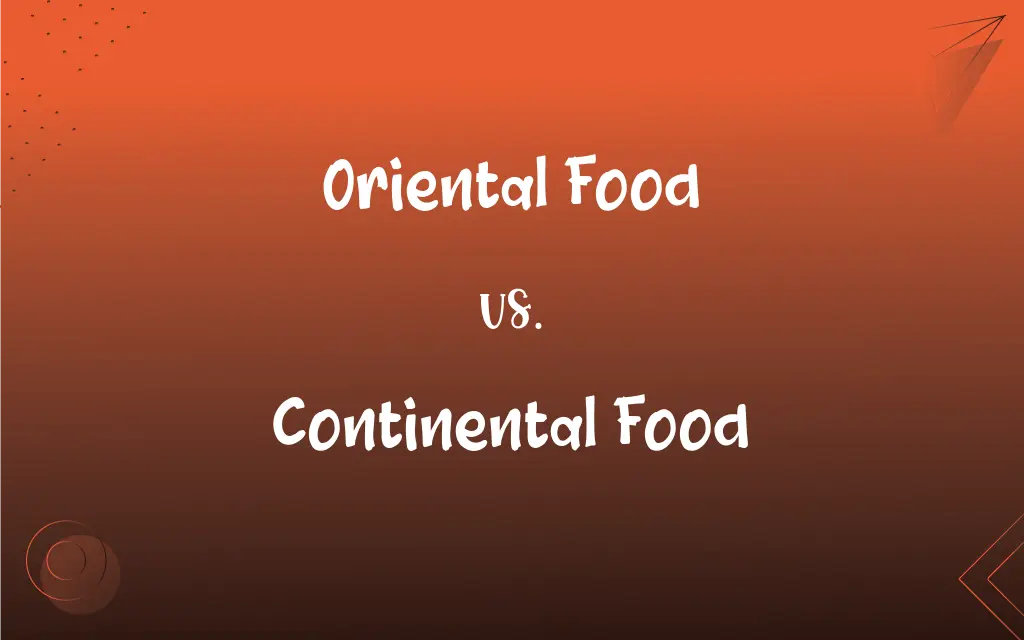Oriental Food vs. Continental Food: What's the Difference?
Edited by Aimie Carlson || By Janet White || Published on October 25, 2023
Oriental food refers to cuisine from Asia, primarily East Asia, while Continental food generally refers to dishes from Europe.

Key Differences
Oriental food, stemming from regions like China, Japan, and Korea, emphasizes rice, noodles, and vegetables, often seasoned with a variety of sauces and spices. In contrast, Continental food, primarily from Europe, focuses on items like bread, cheese, and wine, featuring meats and vegetables prepared with less seasoning.
Oriental food often utilizes cooking techniques like steaming and stir-frying, enabling the preservation of the ingredients' natural flavors. Conversely, Continental food relies heavily on baking and boiling, with an emphasis on the layering of flavors through herbs and sauces.
The staple grains in Oriental food are predominantly rice and noodles, playing a central role in the dietary habits of Eastern cultures. On the other hand, Continental food favors bread and pasta, serving as the foundation of many European meals.
The use of spices is a notable characteristic of Oriental food, imparting intense flavors and aromas. In contrast, Continental food tends to use herbs, offering a more subtle and aromatic seasoning to the dishes.
Oriental food typically features a balance of flavors and textures within a single meal, focusing on the harmony of ingredients. Continental food, however, often emphasizes the individual taste of each component, with a clear distinction between different items on a plate.
ADVERTISEMENT
Comparison Chart
Staple Grains
Rice and noodles.
Bread and pasta.
Cooking Methods
Steaming and stir-frying.
Baking and boiling.
Seasoning
Uses a variety of spices.
Primarily utilizes herbs.
Flavor Profile
Intense and varied flavors.
Subtle and aromatic flavors.
Meal Structure
Balanced flavors and textures.
Distinct individual taste components.
ADVERTISEMENT
Oriental Food and Continental Food Definitions
Oriental Food
Oriental food typically includes a range of spices to enhance taste and aroma.
Spicy ramen exemplifies the flavorful and aromatic nature of oriental food.
Continental Food
Continental food utilizes herbs for subtle and aromatic seasoning.
Herb-crusted fish is a flavorful example of continental food.
Oriental Food
Oriental food is a cuisine rich in rice, noodles, and vegetables, often seasoned with various sauces and spices.
Sushi is a well-known example of oriental food.
Continental Food
Continental food often employs baking and boiling as preferred cooking methods.
A baked chicken breast with herbs is a staple in continental food.
Oriental Food
Oriental food values the balance and unity of ingredients within a single meal.
Bibimbap is a dish in oriental food that harmoniously balances various ingredients.
Continental Food
Continental food includes a variety of cheeses and wines, integral to European cuisine.
Wine and cheese are essential components of continental food.
Oriental Food
Oriental food emphasizes the harmonious blending of different flavors and textures.
A stir-fry is a typical oriental food dish blending various flavors and textures.
Continental Food
Continental food primarily consists of European dishes, featuring bread, pasta, and a variety of meats.
Spaghetti Bolognese is a popular dish in continental food.
Oriental Food
Oriental food often involves cooking methods like steaming and stir-frying.
Dim sum is a popular oriental food, often steamed to perfection.
Continental Food
Continental food focuses on individual taste components, emphasizing the unique flavor of each ingredient.
A cheese platter exemplifies the diverse taste elements found in continental food.
FAQs
Which grains are staple in oriental and continental food?
Rice and noodles are staple in oriental food, while bread and pasta are foundational in continental food.
What is continental food?
Continental food primarily refers to European dishes, focusing on bread, pasta, meats, and often featuring less spicy seasonings.
Are the cooking methods different in oriental and continental food?
Yes, oriental food often involves steaming and stir-frying, whereas continental food typically employs baking and boiling.
Is cheese common in continental food?
Yes, cheese is a prevalent and diverse component in continental food.
What is oriental food?
Oriental food is cuisine from East Asia, characterized by the use of rice, noodles, vegetables, and a variety of spices and cooking methods.
Is oriental food spicier than continental food?
Typically, yes. Oriental food often has a spicier flavor profile compared to the more mild and aromatic flavors of continental food.
How does the seasoning differ in oriental and continental food?
Oriental food uses a variety of spices for intense flavors, while continental food relies more on herbs for subtle, aromatic seasoning.
How does oriental food achieve balanced flavors?
Oriental food achieves balance by harmoniously blending different flavors and textures within a single meal.
Do desserts differ in oriental and continental food?
Yes, oriental desserts often feature ingredients like rice and beans, while continental desserts use more dairy and fruit.
Are vegetables a common component in oriental food?
Yes, vegetables are integral to oriental food, often incorporated in various dishes.
What is the significance of wine in continental food?
Wine is significant in continental food, often paired with meals to complement the flavors.
How does oriental food accommodate different dietary habits?
Oriental food is versatile, offering a range of dishes suitable for varied dietary preferences and restrictions.
How important is the presentation in oriental and continental food?
Presentation is highly valued in both oriental and continental cuisine, with an emphasis on aesthetics and arrangement.
Are the portion sizes different in oriental and continental food?
Generally, oriental food may be served in smaller, shared portions, while continental food often emphasizes individual servings.
Can oriental and continental food be fusioned?
Absolutely, many chefs create fusion dishes that blend elements of oriental and continental food.
About Author
Written by
Janet WhiteJanet White has been an esteemed writer and blogger for Difference Wiki. Holding a Master's degree in Science and Medical Journalism from the prestigious Boston University, she has consistently demonstrated her expertise and passion for her field. When she's not immersed in her work, Janet relishes her time exercising, delving into a good book, and cherishing moments with friends and family.
Edited by
Aimie CarlsonAimie Carlson, holding a master's degree in English literature, is a fervent English language enthusiast. She lends her writing talents to Difference Wiki, a prominent website that specializes in comparisons, offering readers insightful analyses that both captivate and inform.
































































